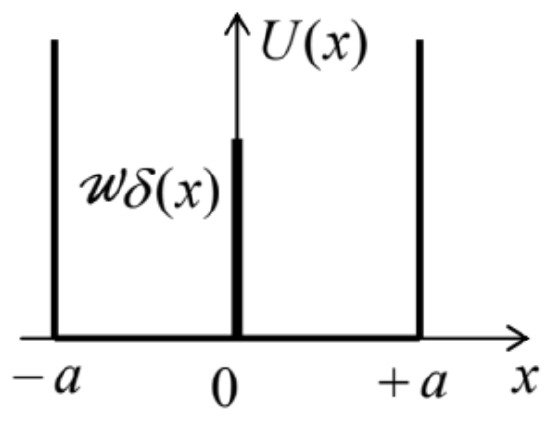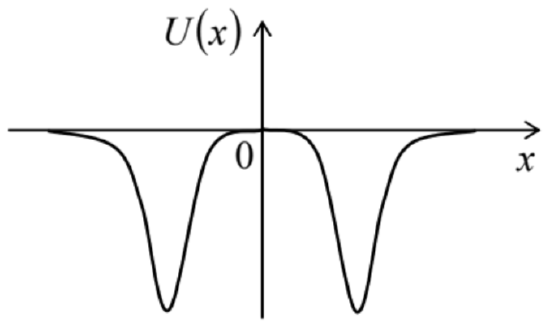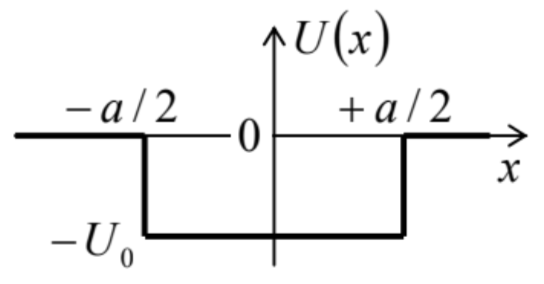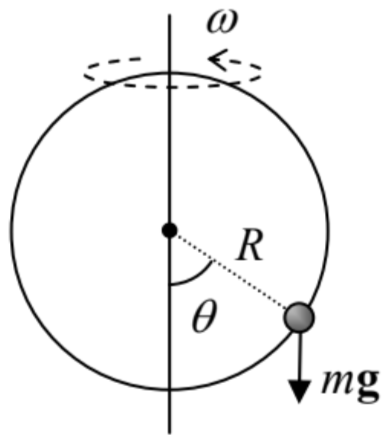2.4: Exercise Problems
( \newcommand{\kernel}{\mathrm{null}\,}\)
2.1. The initial wave packet of a free 1D particle is described by Eq. (20): Ψ(x,0)=∫akeikxdk.
(ii) Calculate ⟨p⟩ for the case when the function |ak|2 is symmetric with respect to some value k0.
2.2. Calculate the function ak defined by Eq. (20), for the wave packet with a rectangular spatial envelope: Ψ(x,0)={Cexp{ik0x}, for −a/2≤x≤+a/2,0, otherwise .
2.3. Prove Eq. (49) for the 1D propagator of a free quantum particle, starting from Eq. (48).
2.4. Express the 1D propagator defined by Eq. (44), via the eigenfunctions and eigenenergies of a particle moving in an arbitrary stationary potential U(x).
2.5. Calculate the change of the wavefunction of a 1D particle, resulting from a short pulse of an external classical force that may be approximated by the delta function: 97 F(t)=Pδ(t).
2.7. Prove Eq. (117) for the case TWKB<<1, using the connection formulas (105).
2.8. Spell out the stationary wavefunctions of a harmonic oscillator in the WKB approximation, and use them to calculate the expectation values ⟨x2⟩ and ⟨x4⟩ for the eigenstate number n⟩>1.
2.9. Use the WKB approximation to express the expectation value of the kinetic energy of a 1D particle confined in a soft potential well, in its nth stationary state, via the derivative dEn/dn, for n>>1.
2.10. Use the WKB approximation to calculate the transparency T of the following triangular potential barrier: U(x)={0, for x<0U0−Fx, for x>0
Hint: Be careful with the sharp potential step at x=0.
2.11. Prove that the symmetry of the 1D scattering matrix S describing an arbitrary timeindependent scatterer, allows its representation in the form (127).
2.12. Prove the universal relations between elements of the 1D transfer matrix T of a stationary (but otherwise arbitrary) scatterer, mentioned in Sec. 5.
2.13. A 1D particle had been localized in a very narrow and deep potential well, with the "energy area" ∫¯U(x)dx equal to −w, where w>0. Then (say, at t=0 ) the well’s bottom is suddenly lifted up, so that the particle becomes completely free. Calculate the probability density, w(k), to find the particle in a state with a certain wave number k at t>0, and the total final energy of the system.
2.14. Calculate the lifetime of the metastable localized state of a 1D particle in the potential U(x)=−wδ(x)−Fx, with w>0,
2.15. Calculate the energy levels and the corresponding eigenfunctions of a 1D particle placed into a flat-bottom potential well of width 2a, with infinitely-high hard walls, and a transparent, short potential barrier in the middle - see the figure on the right. Discuss particle dynamics in the limit when w is very large but still finite.

2.16. ∗ Consider a symmetric system of two potential wells of the type shown in Fig. 21, but with U(0)=U(±∞)=0− see the figure on the right. What is the sign of the well interaction force due to their sharing a quantum particle of mass m, for the cases when the particle is in:
(i) a symmetric localized eigenstate: ψS(−x)=ψs(x) ?
(ii) an antisymmetric localized eigenstate: ψA(−x)=−ψA(x) ?

Use an alternative approach to verify your result for the particular case of delta-functional wells.
2.17. Derive and analyze the characteristic equation for localized eigenstates of a 1D particle in a rectangular potential well of a finite depth (see the figure on the right): U(x)={−U0, for |x|≤a/2,0, otherwise

In particular, calculate the number of localized states as a function of well’s width a, and explore the limit U0<<ℏ2/2ma2. 2.18. Calculate the energy of a 1D particle localized in a potential well of an arbitrary shape U(x), provided that its width a is finite, and the average depth is very small: |ˉU|<<ℏ22ma2, where ˉU≡1a∫well U(x)dx
(i) Use the WKB approximation to derive the characteristic equation for the particle’s energy spectrum, and
(ii) semi-quantitatively describe the spectrum’s evolution at the increase of |W|, for both signs of this parameter.
Make both results more specific for the quadratic-parabolic potential (111): U0(x)=mω20x2/2.
2.20_. Prove Eq. (189), starting from Eq. (188).
2.21. For the problem discussed at the beginning of Sec. 7, i.e. the 1D particle’s motion in an infinite Dirac comb potential shown in Fig. 24 , U(x)=w+∞∑j=−∞δ(x−ja), with w>0,
2.22. A 1D particle of mass m moves in an infinite periodic system of very narrow and deep potential wells that may be described by delta functions: U(x)=w+∞∑j=−∞δ(x−ja), with w<0.
(ii) calculate explicitly the ground state energy of the system in these two limits.
2.23. For the system discussed in the previous problem, write explicit expressions for the eigenfunctions of the system, corresponding to:
(i) the bottom of the lowest energy band,
(ii) the top of that band, and
(iii) the bottom of each higher energy band.
Sketch these functions.
2.24_. The 1D "crystal" analyzed in the last two problems, now extends only to x>0, with a sharp step to a flat potential plateau at x<0 : U(x)={w∑+∞j=1δ(x−ja), with w<0,U0>0, for x>0,
2.25. Calculate the whole transfer matrix of the rectangular potential barrier, specified by Eq. (68), for particle energies both below and above U0.
2.26. Use the results of the previous problem to calculate the transfer matrix of one period of the periodic Kronig-Penney potential shown in Fig. 31b.
2.27. Using the results of the previous problem, derive the characteristic equations for particle’s motion in the periodic Kronig-Penney potential, for both E<U0 and E>U0. Try to bring the equations to a form similar to that obtained in Sec. 7 for the delta-functional barriers - see Eq. (198). Use the equations to formulate the conditions of applicability of the tight-binding and weak-potential approximations, in terms of the system’s parameters, and the particle’s energy E.
2.28. For the Kronig-Penney potential, use the tight-binding approximation to calculate the widths of the allowed energy bands. Compare the results with those of the previous problem (in the corresponding limit).
2.29. For the same Kronig-Penney potential, use the weak-potential limit formulas to calculate the energy gap widths. Again, compare the results with those of Problem 27 , in the corresponding limit.
2.30. 1D periodic chains of atoms may exhibit what is called the Peierls instability, leading to the Peierls transition to a phase in which atoms are slightly displaced, from the exact periodicity, by alternating displacements Δxj=(−1)jΔx, with Δx<<a, where j is the atom’s number in the chain, and a is its initial period. These displacements lead to the alternation of the coupling amplitudes δn (see Eq. (204)) between close values δ+nand δ−n. Use the tight-binding approximation to calculate the resulting change of the nth energy band, and discuss the result.
2.31. " Use Eqs. (1.73)-(1.74) of the lecture notes to derive Eq. (252), and discuss the relation between these Bloch oscillations and the Josephson oscillations of frequency (1.75).
2.32. A 1D particle of mass m is placed to the following triangular potential well: U(x)={+∞, for x<0,Fx, for x>0, with F>0.
(ii) Estimate the ground state energy using the variational method, with two different trial functions.
(iii) Calculate the three lowest energy levels, and also the 10th level, with an accuracy better than 0.1%, from the exact solution of the problem.
(iv) Compare and discuss the results.
Hint: The values of the first zeros of the Airy function, necessary for Task (iii), may be found in many math handbooks, for example, in Table 9.9.1 of the online version of the collection edited by Abramowitz and Stegun - see MA Sec. 16(i).
2.33_. Use the variational method to estimate the ground state energy Eg of a particle in the following potential well: U(x)=−U0exp{−αx2}, with α>0, and U0>0.
2.34. For a 1D particle of mass m, placed to a potential well with the following profile, U(x)=ax2s, with a>0, and s>0,
(ii) estimate the ground state energy using the variational method.
Compare the ground-state energy results for the parameter s equal to 1,2,3, and 100 .
2.35. Use the variational method to estimate the 1st excited state of the 1D harmonic oscillator.
2.36. Assuming the quantum effects to be small, calculate the lower part of the energy spectrum of the following system: a small bead of mass m, free to move without friction along a ring of radius R, which is rotated about its vertical diameter with a constant angular velocity ω− see the figure on the right. Formulate a quantitative condition of validity of your results.
Hint: This system was used as the analytical mechanics’ "testbed problem" in the CM part of this series, and the reader is welcome to use any relations derived there.

2.37. A 1D harmonic oscillator, with mass m and frequency ω0, had been in its ; then an additional force F was suddenly applied, and after that kept constant. Calculate the probability of the oscillator staying in its ground state.
2.38. A 1D particle of mass m has been placed to a quadratic potential well (111), U(x)=mω20x22,
2.40. A 1D particle is placed into the following potential well: U(x)={+∞, for x<0,mω20x2/2, for x≥0.
(ii) This system had been let to relax into its ground state, and then the potential wall at x<0 was rapidly removed so that the system was instantly turned into the usual harmonic oscillator (with the same m and ω0 ). Find the probability for the oscillator to remain in its ground state.
2.41. Prove the following formula for the propagator of the 1D harmonic oscillator: G(x,t;x0,t0)=(mω02πiℏsin[ω0(t−t0)])1/2exp{imω02ℏsin[ω0(t−t0)][(x2+x20)cos[ω0(t−t0)]−2xx0]}.
2.42. In the context of the Sturm oscillation theorem mentioned in Sec. 9, prove that the number of eigenfunction’s zeros of a particle confined in an arbitrary but finite potential well always increases with the corresponding eigenenergy.
Hint: You may like to use the suitably modified Eq. (186).
2.43. ∗ Use the WKB approximation to calculate the lifetime of the metastable ground state of a 1D particle of mass m in the "pocket" of the potential profile U(x)=mω202x2−αx3.
97 The constant P is called the force’s impulse. (In higher dimensionalities, it is a vector - just as the force is.)
98 In applications to electrons in solid-state crystals, the delta-functional potential wells model the attractive potentials of atomic nuclei, while U0 represents the workfunction, i.e. the energy necessary for the extraction of an electron from the crystal to the free space - see, e.g., Sec. 1.1(ii), and also EM Sec. 2.6 and SM Sec. 6.3.


